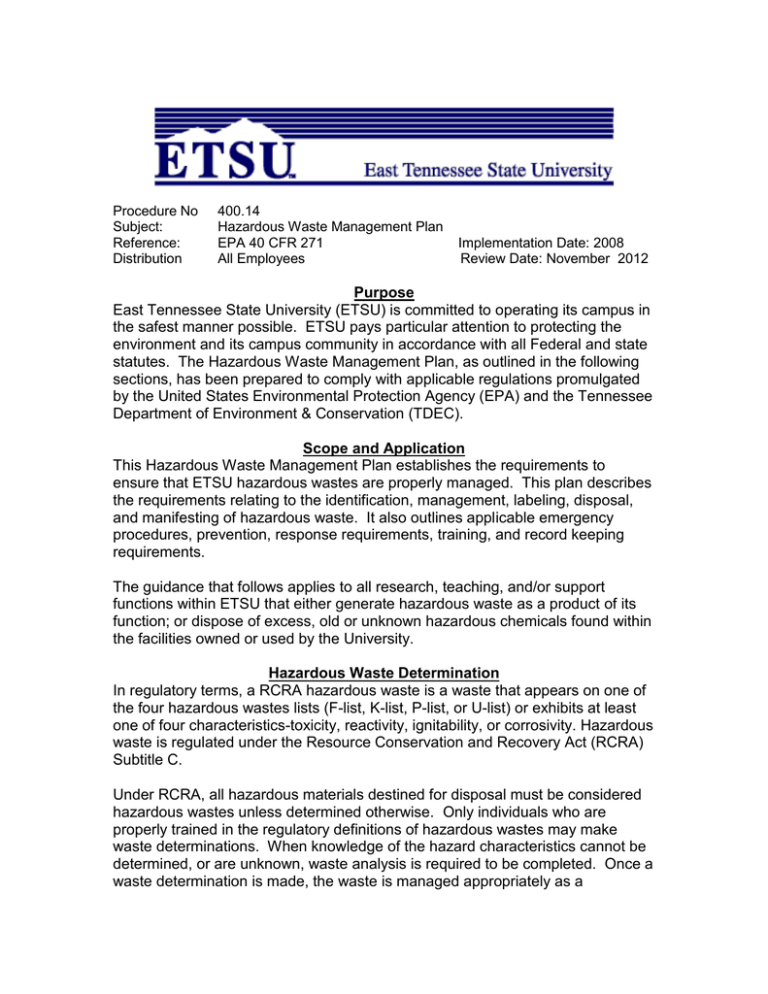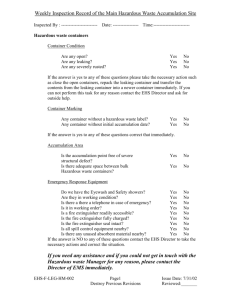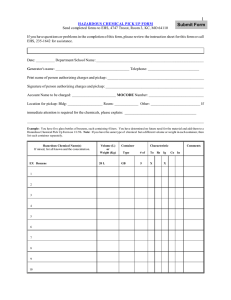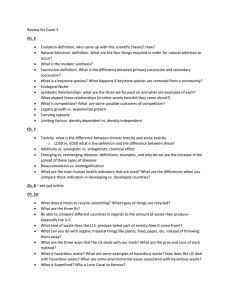Document 11260429
advertisement

Procedure No Subject: Reference: Distribution 400.14 Hazardous Waste Management Plan EPA 40 CFR 271 All Employees Implementation Date: 2008 Review Date: November 2012 Purpose East Tennessee State University (ETSU) is committed to operating its campus in the safest manner possible. ETSU pays particular attention to protecting the environment and its campus community in accordance with all Federal and state statutes. The Hazardous Waste Management Plan, as outlined in the following sections, has been prepared to comply with applicable regulations promulgated by the United States Environmental Protection Agency (EPA) and the Tennessee Department of Environment & Conservation (TDEC). Scope and Application This Hazardous Waste Management Plan establishes the requirements to ensure that ETSU hazardous wastes are properly managed. This plan describes the requirements relating to the identification, management, labeling, disposal, and manifesting of hazardous waste. It also outlines applicable emergency procedures, prevention, response requirements, training, and record keeping requirements. The guidance that follows applies to all research, teaching, and/or support functions within ETSU that either generate hazardous waste as a product of its function; or dispose of excess, old or unknown hazardous chemicals found within the facilities owned or used by the University. Hazardous Waste Determination In regulatory terms, a RCRA hazardous waste is a waste that appears on one of the four hazardous wastes lists (F-list, K-list, P-list, or U-list) or exhibits at least one of four characteristics-toxicity, reactivity, ignitability, or corrosivity. Hazardous waste is regulated under the Resource Conservation and Recovery Act (RCRA) Subtitle C. Under RCRA, all hazardous materials destined for disposal must be considered hazardous wastes unless determined otherwise. Only individuals who are properly trained in the regulatory definitions of hazardous wastes may make waste determinations. When knowledge of the hazard characteristics cannot be determined, or are unknown, waste analysis is required to be completed. Once a waste determination is made, the waste is managed appropriately as a hazardous waste or discarded as a non-hazardous waste. All waste determinations must be maintained in writing and on file for a minimum of three years. A chemical must never be placed in the building solid waste (trash) or poured down a drain unless it has been determined that the chemical is not a hazardous waste and is acceptable for disposal through such means. Liquids should never be placed in the building solid waste as liquids are not acceptable for landfill disposal because they can migrate or leach into the ground water. Chemical wastes are classified as hazardous waste by being specifically listed as a hazardous waste in federal and/or state regulations, or based on characteristics of ignitability, reactivity, corrosivity or toxicity. Characteristics of a Hazardous Waste Ignitability A solid waste exhibits the characteristic of ignitability if a representative sample of the waste has any of the following properties: It is a liquid, other than an aqueous solution containing less than 24 percent alcohol by volume and has flash point less than 60 °C (140 °F), as determined by a Pensky-Martens Closed Cup Tester, using the test method specified in ASTM Standard D 93-79 or D 93-80 (incorporated by reference, see § 260.11), or a Setaflash Closed Cup Tester, using the test method specified in ASTM Standard D 3278-78 (incorporated by reference, see § 260.11). It is not a liquid and is capable, under standard temperature and pressure, of causing fire through friction, absorption of moisture or spontaneous chemical changes and, when ignited, burns so vigorously and persistently that it creates a hazard. It is an ignitable compressed gas. A solid waste that exhibits the characteristic of ignitability has the EPA Hazardous Waste Number of D001. Corrosivity A solid waste exhibits the characteristic of corrosivity if a representative sample of the waste has either of the following properties: It is aqueous and has a pH less than or equal to 2 or greater than or equal to 12.5, as determined by a pH meter using Method 9040C in “Test Methods for Evaluating Solid Waste, Physical/Chemical Methods,” EPA Publication SW-846, as incorporated by reference in § 260.11 of this chapter. It is a liquid and corrodes steel (SAE 1020) at a rate greater than 6.35 mm (0.250 inch) per year at a test temperature of 55 °C (130 °F) as determined by Method 1110A in “Test Methods for Evaluating Solid Waste, Physical/Chemical Methods,” EPA Publication SW-846, and as incorporated by reference in § 260.11 of this chapter. A solid waste that exhibits the characteristic of corrosivity has the EPA Hazardous Waste Number of D002. Reactivity A solid waste exhibits the characteristic of reactivity if a representative sample of the waste has any of the following properties: It is normally unstable and readily undergoes violent change without detonating. It reacts violently with water. It forms potentially explosive mixtures with water. When mixed with water, it generates toxic gases, vapors or fumes in a quantity sufficient to present a danger to human health or the environment. It is a cyanide or sulfide bearing waste which, when exposed to pH conditions between 2 and 12.5, can generate toxic gases, vapors or fumes in a quantity sufficient to present a danger to human health or the environment. It is capable of detonation or explosive reaction if it is subjected to a strong initiating source or if heated under confinement. It is readily capable of detonation or explosive decomposition or reaction at standard temperature and pressure. It is a forbidden explosive as defined in 49 CFR 173.54, or is a Division 1.1, 1.2 or 1.3 explosive as defined in 49 CFR 173.50 and 173.53. A solid waste that exhibits the characteristic of reactivity has the EPA Hazardous Waste Number of D003. Toxicity A solid waste (except manufactured gas plant waste) exhibits the characteristic of toxicity if, using the Toxicity Characteristic Leaching Procedure, test Method 1311 in “Test Methods for Evaluating Solid Waste, Physical/Chemical Methods,” A solid waste that exhibits the characteristic of toxicity has the EPA Hazardous Waste Number specified in Table 1 which corresponds to the toxic contaminant causing it to be hazardous. Table 1 —Maximum Concentration of Contaminants for the Toxicity Characteristic EPA HW No. 1 Contaminant CAS No. 2 Regulatory Level (mg/L) D004 Arsenic 7440-38-2 5.0 D005 Barium 7440-39-3 100.0 D018 Benzene 71-43-2 0.5 D006 Cadmium 7440-43-9 1.0 D019 Carbon tetrachloride 56-23-5 0.5 D020 Chlordane 57-74-9 0.03 D021 Chlorobenzene 108-90-7 100.0 D022 Chloroform 67-66-3 6.0 D007 Chromium 7440-47-3 5.0 D023 o-Cresol 95-48-7 4 200.0 D024 m-Cresol 108-39-4 4 200.0 D025 p-Cresol 106-44-5 4 200.0 D026 Cresol 4 200.0 D016 2,4-D D027 94-75-7 10.0 1,4-Dichlorobenzene 106-46-7 7.5 D028 1,2-Dichloroethane 107-06-2 0.5 D029 1,1-Dichloroethylene 75-35-4 0.7 D030 2,4-Dinitrotoluene D012 Endrin 72-20-8 0.02 D031 Heptachlor (and its epoxide) 76-44-8 0.008 D032 Hexachlorobenzene 118-74-1 D033 Hexachlorobutadiene 87-68-3 0.5 D034 Hexachloroethane 67-72-1 3.0 D008 Lead 7439-92-1 5.0 D013 Lindane 58-89-9 0.4 D009 Mercury 7439-97-6 0.2 D014 Methoxychlor 72-43-5 10.0 D035 Methyl ethyl ketone 78-93-3 200.0 D036 Nitrobenzene 98-95-3 2.0 D037 Pentrachlorophenol 87-86-5 100.0 D038 Pyridine 121-14-2 110-86-1 3 3 0.13 0.13 3 5.0 D010 Selenium 7782-49-2 1.0 D011 Silver 7440-22-4 5.0 D039 Tetrachloroethylene 127-18-4 0.7 D015 Toxaphene 8001-35-2 0.5 D040 Trichloroethylene 79-01-6 0.5 D041 2,4,5-Trichlorophenol 95-95-4 400.0 D042 2,4,6-Trichlorophenol 88-06-2 2.0 D017 2,4,5-TP (Silvex) 93-72-1 1.0 D043 Vinyl chloride 75-01-4 0.2 Basic Hazardous Waste Management Rules Once your department has determined that a waste is hazardous, it is important to do the following: Accumulate waste in containers that are clean, in good condition, chemically compatible, and appropriate for the quantity accumulated. If small quantities are accumulated in larger containers, do not combine different kinds of waste unless you know that they are compatible and are acceptable for disposal in the combined form. Flammables must be stored away from oxidizers, water reactive chemicals away from moisture, acids away from bases, etc. Containers must be within a secure area where any leak will not cause harm to the environment. Containers must be closed at all times unless waste is being actively added to or removed from the container. Label the waste container with the date accumulation started, identity of the contents with no abbreviations, quantity of each constituent, and the words “Hazardous Waste.” Schedule removal of the waste in a timely fashion by using the Hazardous Waste Pickup Request Form at http://healthsafety.etsu.edu/static/pickupform. Use the ETSU Hazardous Waste tags provided by the EHS Office to properly identify your hazardous waste. Install and maintain emergency equipment to be used in case of a spill. Keep the Emergency Contact signage that is located outside of every lab current and up to date order. Never accumulate over 55 gallons of hazardous waste in individual lab. Hazardous Waste Accumulation Two types of hazardous waste accumulation points are present at ETSU: Accumulation Points Satellite Accumulation Points A hazardous waste accumulation point is a location on-site at which hazardous waste can be accumulated for up to 90 days without a permit. At an accumulation point, any amount of hazardous waste can be collected and stored providing no container remains in the accumulation point storage for over 90 days. If hazardous waste is added to a container at the accumulation point, the 90 day limit for that container begins as soon as the first waste is added to the container. For this reason, container size selection is very important in minimizing costs when accumulating in these areas. Estimate your waste volume carefully while allowing for extra time to arrange shipping. It is recommended that you chose a container size that you can fill within a 30 or 60 day period in this situation. A satellite accumulation point is a location at or near the point of generation that is under the control of the operator of the process generating the waste. No more than 55 gallons of hazardous waste or one quart of acute hazardous waste can be accumulated at a satellite accumulation point. The difference between a satellite accumulation point and an accumulation point are the volume and the length of time wastes may be accumulated. At a satellite accumulation point, up to 55 gallons of hazardous waste or up to one quart of acute hazardous waste may be accumulated for a reasonable amount of time. At an accumulation point, an unlimited volume of waste may be accumulated in containers for up to 90 days. If a facility has not been approved by the ETSU EHS Office to maintain a hazardous waste accumulation point, then they are, by default, satellite accumulation points and must stay in status with the volumes stated above. Hazardous waste must be kept in designated areas at all times. Wastes that are accumulated in these areas must be managed in accordance with the procedures specified below. The generator is responsible for ensuring compliance with these procedures for his/her hazardous waste satellite accumulation point(s). The Environmental Compliance Manager is responsible for managing the Central Hazardous Waste Accumulation Building(s) in compliance with these procedures. All hazardous waste Accumulation Points must meet the following requirements: A Hazardous Waste sign must be posted at each area. The name and phone number of the accumulation point supervisor and an alternate contact must be posted at each area. The area should be used for hazardous waste accumulation only. No raw materials or chemical stock should be stored in the same area with hazardous waste. The area must be located at or near the point of waste generation and must be under the control of the person responsible for the wastegenerating process. All containers will be appropriately labeled and segregated for compatibility. Access to the hazardous waste accumulation points and building must never be blocked. The area shall be quickly and easily accessible by emergency response personnel in the event of a spill, leak or fire. Appropriate emergency response equipment shall be maintained for each hazardous waste accumulation and satellite area. The accumulation point supervisor is responsible for ensuring the equipment is in good condition at each of his/her accumulation points. The Environmental Compliance Manager is responsible for the Central Hazardous Waste Accumulation Building(s). Emergency equipment shall include the following: Fire extinguisher, 20lb ABC type. Absorbent of the proper type and of sufficient amount to absorb the volume present. Broom, bucket and mop. Telephone or other communication device. First aid kit. Safety shower and eye wash station as applicable. Coveralls, eye protection and gloves compatible with wastes. Empty containers and bags compatible with cleanup characteristics. Labeling and Marking An approved hazardous waste label shall be affixed to each hazardous waste container prior to receiving any waste material. The Environmental Compliance Manager is responsible for ensuring each container is properly labeled before being picked up from a Satellite Accumulation Point or an Accumulation Point and moved to the Central Accumulation Point. However, the Generator or Accumulation Point Supervisor responsible for the waste is responsible for ensuring each container in his/her area is properly labeled before placing waste into the container or receiving any waste into an Accumulation Point. The following information shall be provided on each hazardous waste label: The words HAZARDOUS WASTE. List of individual chemicals contained within the container and percentages or amount of each chemical. Hazard characteristics of the waste (e.g. flammable, corrosive, oxidizer). The accumulation start date. The labels shall be placed on the side of each container in such a manner that they are clearly visible for inspection. WASTE CONTAINERS ARE REQUIRED TO BE LABELED, BY THE GENERATOR, AS SOON AS THE FIRST DROP OF WASTE IS PLACED INTO THE CONTAINER! Spill Response Make sure everyone knows where the spill response materials are for their work area and are familiar on how to use them. If there is a chemical spill within your respected area, the department personnel will be the first responder. Determine if the spill can be safely cleaned-up with existing personnel and resources. If you are ever uncertain to whether the spill can safely be cleaned up, contact the EH&S Office at (9-6028) and Public Safety (911) notifying them of the location and material spilled. The following are some general spill response guidelines: Immediately alert area occupants and supervisor, and evacuate the area, if necessary If there is a fire or a medical emergency, notify Public Safety at 911 Attend to anyone who may be contaminated. Contaminated clothing must be removed immediately and the skin flushed with water for no less than 15 minutes. If a flammable material is spilled, immediately warn everyone, control sources of ignition and ventilate the area Don personal protective equipment appropriate for the hazard(s) If respiratory protection is needed immediately evacuate and restrict the area. Notify EH&S (9-6028) and Public Safety (911). Loose spill control materials should be distributed over the entire spill area, working from the outside, circling to the inside. This reduces the chance of splash or spread of the spilled chemical POWERSORB (by 3M) products or their equivalent will handle hydrofluoric acid. Specialized hydrofluoric acid kits also are available. Many neutralizers for acids or bases have a color change indicator to show when neutralization is complete When spilled material have been absorbed, use a brush and scoop to place material in an appropriate container Five gallon pails are the preferred containers for collecting the clean-up material Universal Waste Universal wastes are not hazardous wastes if properly recycled. Types of universal wastes consist of the following: Batteries (nickel cadmium and lead acid) Certain Pesticides Mercury containing thermostats Thermometers Fluorescent lamps/bulbs All universal waste streams are to be segregated and stored in a designated satellite storage area. Each container must have a designated description label attached (“Used Fluorescent Bulbs” or “Waste Batteries”) and the accumulation start date written in the label or container. These labels are provided by the EHS Office. Containers used to store universal waste must be structurally sound, adequate to prevent breakage and compatible with the contents. It is best to use the original package that the device or material was shipped in. All universal waste containers must remain closed, leak free and have the accumulation start date on them. Universal waste may be stored onsite for up to one year. For collection, please submit a chemical waste pick-up request form on-line or call the EHS Office at 9-6028. Facility Personnel Training There shall be at least two EHS employees at ETSU who receive DOT Hazardous Materials and RCRA annual training, to ensure that hazardous waste manifests are completed properly. Only those individuals who have completed this training requirement are to sign hazardous waste manifests on behalf of ETSU. Copies of the training certificates will be retained for at least a period of three years in the EHS Office. Training All ETSU faculty and staff who generate or handle hazardous wastes will be trained on this Hazardous Waste Management Plan and/or the following module on an annual basis http://healthsafety.etsu.edu/training/preview/id/7. Written documentation of each training session, including a signature and date of the person trained, will be maintained in the EHS Office for a minimum of three years.






